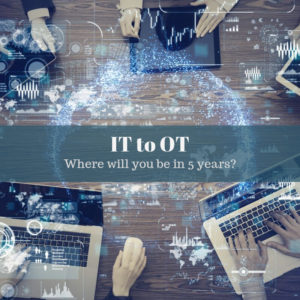IT to OT
Integrating Information Technology with Operational Technology
What are the Challenges?
The common challenge manufacturers face when integrating new technology to drive efficiencies is most often having a “connected” system. Three usual issues prevent manufacturing companies from pursuing a connected system including human barriers, rising costs, and a lack of proficient products all contribute to manufacturers’ confusion on what and how to implement new systems for the betterment of their organization.
This is not a huge problem for all organizations but tends to arise as a problem in many industries: Bringing people in the organization together to connect with the product. Human barriers between departments such as IT and Operations Teams have a hard time finding solutions to some of their most common problems solely for the reason that they cannot find sufficient solutions together and tie their systems to one another. The human barrier is what frustrates the company internally and causes the organization to give up on pursuing the right solution for them. Smaller organizations usually don’t have the proper development teams, time, or capital to invest in technology for integration between departments.
Rising costs seems to be a recurring problem that paralyzes companies among industries from connecting systems. The continuous costs of hiring professionals, licensing software/ hardware, and the time that is costs to take on larger projects like such can put a damper on the decision of moving forward with “smarter” systems; they don’t seem so smart when it takes such investment commitment, right? With larger software organizations falsifying hopes and charging more money per installment, it is hard to jump on board with making a company-wide change for something that “might” pay off.
Even when larger software organizations offer new products and technology, most of the time it does not even solve the problems of the end-user. Who creates products without talking to the people that are going to be using it? It sounds like common sense, but many organizations don’t research before launching a new product. The manufacturing market is saturated with MES, ERP, and many other technologies that just don’t fill the gap that real users have. Of course, there is an abundance of products that you can piece together until you get a full solution, but many providers do not offer a wide range of functionality or connection between products.
Are there benefits of Connecting IT to OT?
Just as there are common problems/ issues, there are also common advantages to having a synergistic system in your manufacturing plant. Connecting systems allows for improved clarity, business decisions, and an understanding of how your systems support one another.
One of the most important aspects of connecting IT to OT is the digital support system that your organization will experience. Likely, your organization has previously invested in an IT infrastructure and Operational Technology that allows insights on different levels of business. By connecting these, it allows your business to leverage existing resources and tools without incurring other large expenses.
As companies begin to digitize their operations, it creates a blur when trying to find insights. This is easily combated by connecting the digitizations and having them communicate openly with each other. With business processes becoming so technology-dependent and OT perpetuating/ embedding more technology in production processes, it provides managers, executives, and owners with more visibility on how technology processes are positively impacting the physical practices of manufacturing. With technologies openly interacting with one another, this can help management drag deeper insights from both sides of the equation.
Now, how do I do that?
With these deeper insights, we are beginning to get into analytics. Both types of technologies provide crucial data to the organization regarding operational processes, human behavior, and customer feedback important to the overall success of the organization. We must begin to think about how this information is beginning to impact decision-makers and where it will take the organization with a more connected system.
As data analytics is proven to drive efficiencies, there’s no question that keeping things connected helps the process of insightful decision-making. By connecting IT to OT, it allows the decision-maker to understand how each component impacts the other on an operational and technological standpoint. In the end, this will help the organization gain a competitive advantage and vastly increases its operational efficiency.
There are many technologies on the market for IT and just as many for OT, but what seems to be the common problem is the technology that will synergize the two. There aren’t many systems in which you can connect all of your organization’s technology in one place. Luckily, a few technology providers have been able to solve this common problem by performing custom integrations with existing technology so companies can gain a holistic view. As you can imagine, this is rare and not yet adopted by the mass of manufacturers. Another way to connect internal systems is to build the system yourself with your team. This isn’t the most glamorous or easy thing to do, but in the end it’s dependent on what works best for the business.
